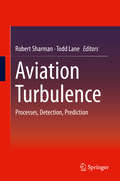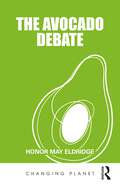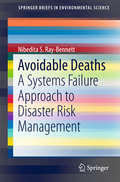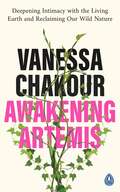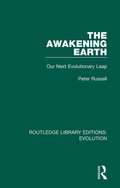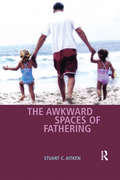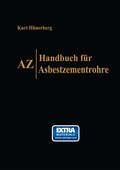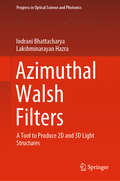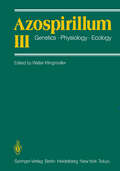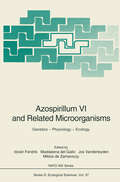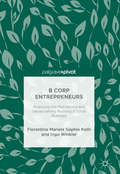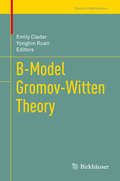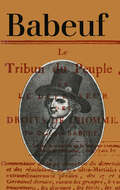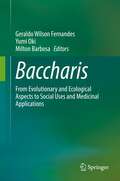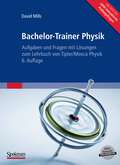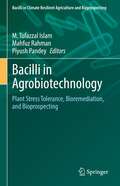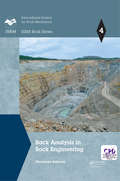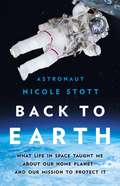- Table View
- List View
Aviation Turbulence: Processes, Detection, Prediction
by Robert Sharman Todd LaneAnyone who has experienced turbulence in flight knows that it is usually not pleasant, and may wonder why this is so difficult to avoid. The book includes papers by various aviation turbulence researchers and provides background into the nature and causes of atmospheric turbulence that affect aircraft motion, and contains surveys of the latest techniques for remote and in situ sensing and forecasting of the turbulence phenomenon. It provides updates on the state-of-the-art research since earlier studies in the 1960s on clear-air turbulence, explains recent new understanding into turbulence generation by thunderstorms, and summarizes future challenges in turbulence prediction and avoidance.
Avocado Anxiety: and Other Stories About Where Your Food Comes From
by Louise GrayThe food stories behind your favourite fruits and vegetables. Have you ever wondered who picked your Fairtrade banana? Or why we can buy British strawberries in April? How far do you think your green beans travelled to get to your plate? And where do all the wonky carrots go? Above all, how do we stop worrying about our food choices and start making decisions that make a difference?In an effort to make sense of the complex food system we are all part of, Louise Gray decides to track the stories of our five-a-day, from farm to fruit bowl, and discover the impact that growing fruits and vegetables has on the planet. Through visits to farms, interviews with scientists and trying to grow her own, she digs up the dirt behind organic potatoes, greenhouse tomatoes and a glut of courgettes. In each chapter, Louise answers a question about a familiar item in our shopping basket. Is plant protein as good as meat? Is foraged food more nutritious? Could bees be the answer to using fewer chemicals? How do we save genetic diversity in our apples? Are digital apps the key to reducing food waste? Is gardening good for mental health? And is the symbol of clean eating, the avocado, fuelling the climate crisis? As pressure grows via social media to post pictures of food that ticks all the boxes in terms of health and the environment, these food stories from the author of the award-winning The Ethical Carnivore are also a personal story of motherhood and the realisation that nothing is ever perfect.
Avocado Anxiety: and Other Stories About Where Your Food Comes From
by Louise GrayThe food stories behind your favourite fruits and vegetables. Have you ever wondered who picked your Fairtrade banana? Or why we can buy British strawberries in April? How far do you think your green beans travelled to get to your plate? And where do all the wonky carrots go? Above all, how do we stop worrying about our food choices and start making decisions that make a difference?In an effort to make sense of the complex food system we are all part of, Louise Gray decides to track the stories of our five-a-day, from farm to fruit bowl, and discover the impact that growing fruits and vegetables has on the planet. Through visits to farms, interviews with scientists and trying to grow her own, she digs up the dirt behind organic potatoes, greenhouse tomatoes and a glut of courgettes. In each chapter, Louise answers a question about a familiar item in our shopping basket. Is plant protein as good as meat? Is foraged food more nutritious? Could bees be the answer to using fewer chemicals? How do we save genetic diversity in our apples? Are digital apps the key to reducing food waste? Is gardening good for mental health? And is the symbol of clean eating, the avocado, fuelling the climate crisis? As pressure grows via social media to post pictures of food that ticks all the boxes in terms of health and the environment, these food stories from the author of the award-winning The Ethical Carnivore are also a personal story of motherhood and the realisation that nothing is ever perfect.
The Avocado Debate (Changing Planet)
by Honor May EldridgeWhether smashed on toast or hailed as a superfood, the avocado has taken the world by storm, but what are the environmental and social impacts of this trendy fruit? This book does not seek to demonise the avocado and its many enthusiasts. Instead, it will illuminate consumers on the often unseen impacts of foods. A staple of cafes, restaurants, homes, and social media channels, demand for the avocado has grown exponentially over the past thirty years. From an everyday crop in South and Central America to a global phenomenon, this drastic change in demand has many consequences for people and the planet. As demand grows, so does the need for more land, with land clearances threatening habitats and biodiversity. As production grows, so does global distribution and the impacts that air and sea travel have on the environment. The shift from a local to a global product disturbs the local food system, raising serious questions around food sovereignty and food justice and the importance of establishing an agricultural system that is both environmentally and socially just. While focusing here on the avocado, this book allows readers to gain a better understanding of the food system as a whole. In doing so, it empowers us all to think carefully and critically about the environmental and ethical implications of our food choices more broadly. We shouldn’t feel guilty about eating avocados, we should simply understand the impact of doing so. This book is essential reading for all who are interested in learning more about the food system, sustainable diets, and the relationship between farming and the environment.
The Avocado Debate (Changing Planet)
by Honor May EldridgeWhether smashed on toast or hailed as a superfood, the avocado has taken the world by storm, but what are the environmental and social impacts of this trendy fruit? This book does not seek to demonise the avocado and its many enthusiasts. Instead, it will illuminate consumers on the often unseen impacts of foods. A staple of cafes, restaurants, homes, and social media channels, demand for the avocado has grown exponentially over the past thirty years. From an everyday crop in South and Central America to a global phenomenon, this drastic change in demand has many consequences for people and the planet. As demand grows, so does the need for more land, with land clearances threatening habitats and biodiversity. As production grows, so does global distribution and the impacts that air and sea travel have on the environment. The shift from a local to a global product disturbs the local food system, raising serious questions around food sovereignty and food justice and the importance of establishing an agricultural system that is both environmentally and socially just. While focusing here on the avocado, this book allows readers to gain a better understanding of the food system as a whole. In doing so, it empowers us all to think carefully and critically about the environmental and ethical implications of our food choices more broadly. We shouldn’t feel guilty about eating avocados, we should simply understand the impact of doing so. This book is essential reading for all who are interested in learning more about the food system, sustainable diets, and the relationship between farming and the environment.
Avoidable Deaths: A Systems Failure Approach to Disaster Risk Management (SpringerBriefs in Environmental Science)
by Nibedita S. Ray-BennettThis book addresses one of the most fundamental questions of the 21st century: why deaths continue to occur in natural disasters despite the tremendous advancements in disaster management science and weather forecasting systems, increased sophistication of human-built environments and ongoing economic and policy development worldwide. By presenting an interdisciplinary tool for analysing ‘systems failure’, the book provides concrete suggestions on how deaths may be reduced in resource-poor contexts. It goes beyond traditional risk and vulnerability perspectives and demonstrates that deaths in disasters are complex problems that can be solved by adopting a socio-technical perspective to improve current disaster management systems in the developing world. The book is a timely contribution, as it directly addresses Global Target One of the UN’s ‘Sendai Framework for Disaster Risk Reduction’, which has urged 185 UN Member States to reduce disaster mortality by 2030. Further, it offers a valuable resource for students, researchers, policy-makers and practitioners interested in disaster risk reduction, human rights, gender, sociology of risk, crisis and disasters, environmental science, organisation and management studies.
Awakening Artemis: Deepening Intimacy with the Living Earth and Reclaiming Our Wild Nature
by Vanessa ChakourWe all come from different cultures and practice different spiritual traditions, but we have one thing in common: we are all of the earth. Vanessa Chakour, founder of the rewilding programme Sacred Warrior, takes us on a journey to deepen our relationship with ourselves and the environment. Awakening Artemis is her love letter to the earth.Sharing her personal journey of rewilding, her stories act as tools, both practical and inspirational, to encourage growth, healing and reconnection to the regenerative power of the natural world. Vanessa will help you embrace the strength and beauty in the wild, the weeds, and the unsavoury parts of yourself in order to grow and heal. By allowing yourself and the earth to flourish and awakening your inner Artemis, Chakour promises that you will find joy, peace, compassion for yourself, others, and the planet.
The Awakening Earth: Our Next Evolutionary Leap (Routledge Library Editions: Evolution #11)
by Peter RussellOriginally published in 1982 The Awakening Earth explores the idea of the Earth as a collective, self-regulatory living organism, and considers in this context, the function of the human race. The book provides an exploration of humanity’s potential and explores the possibility of mankind’s evolutionary future. Drawing on the work of physicists, psychologists, philosophers and mystics, the book argues that humanity is on the verge of another evolutionary leap and explores evolution in the context of spiritual growth, arguing that widespread inner awakenings could lead to a more analogous society, functioning as a single social super-organism, much in the way cells in a body function as a biological organism.
The Awakening Earth: Our Next Evolutionary Leap (Routledge Library Editions: Evolution #11)
by Peter RussellOriginally published in 1982 The Awakening Earth explores the idea of the Earth as a collective, self-regulatory living organism, and considers in this context, the function of the human race. The book provides an exploration of humanity’s potential and explores the possibility of mankind’s evolutionary future. Drawing on the work of physicists, psychologists, philosophers and mystics, the book argues that humanity is on the verge of another evolutionary leap and explores evolution in the context of spiritual growth, arguing that widespread inner awakenings could lead to a more analogous society, functioning as a single social super-organism, much in the way cells in a body function as a biological organism.
The Awkward Spaces of Fathering
by Stuart C. AitkenSocietal notions of fathers have evolved from the distant breadwinner through genial dad and masculine role model to today's equal co-parent. This book seeks to explore the spaces and movements of men-as-fathers. Weaving together theories of space, sexuality and political identity with the stories of fathers from a range of sources, including popular culture, it discusses the way in which geographies of space can disconnect and disempower fathers, while societal notions marginalize and disassociate them from raising children. It explores how fathering identities are shaped by family and community spaces and aims to move the definition of 'fathering' beyond its definition in opposition to 'mothering'. In doing so, it provides insights into the contradictory nature of father's lives and argues that, rather than moving away from the traditional notions of masculine roles, that the emotional work of fathering in itself is an heroic act.
The Awkward Spaces of Fathering
by Stuart C. AitkenSocietal notions of fathers have evolved from the distant breadwinner through genial dad and masculine role model to today's equal co-parent. This book seeks to explore the spaces and movements of men-as-fathers. Weaving together theories of space, sexuality and political identity with the stories of fathers from a range of sources, including popular culture, it discusses the way in which geographies of space can disconnect and disempower fathers, while societal notions marginalize and disassociate them from raising children. It explores how fathering identities are shaped by family and community spaces and aims to move the definition of 'fathering' beyond its definition in opposition to 'mothering'. In doing so, it provides insights into the contradictory nature of father's lives and argues that, rather than moving away from the traditional notions of masculine roles, that the emotional work of fathering in itself is an heroic act.
Azimuthal Walsh Filters: A Tool to Produce 2D and 3D Light Structures (Progress in Optical Science and Photonics #10)
by Indrani Bhattacharya Lakshminarayan HazraThis book explores the possibility of using azimuthal Walsh filters as an effective tool for manipulating far-field diffraction characteristics near the focal plane of rotationally symmetric imaging systems. It discusses the generation and synthesis of azimuthal Walsh filters, and explores the inherent self-similarity presented in various orders of these filters, classifying them into self-similar groups and sub-groups. Further, it demonstrates that azimuthal Walsh filters possess a unique rotational self-similarity exhibited among adjacent orders. Serving as an atlas of diffraction phenomena with pupil functions represented by azimuthal Walsh filters of different orders, this book describes how orthogonality and self-similarity of these filters could be harnessed to sculpture 2D and 3D light distributions near the focus.
Azospirillum III: Genetics · Physiology · Ecology Proceedings of the Third Bayreuth Azospirillum Workshop
by Walter KlingmüllerAzospirillum VI and Related Microorganisms: Genetics — Physiology — Ecology (Nato ASI Subseries G: #37)
by Istvan Fendrik Maddalena Del Gallo Jos Vanderleyden De Zamaroczy MiklosAzospirillum is a plant growth promoting rhizobacterium used for inoculation of cereal and forage crops. The book covers its physiology, ecology, biochemistry, and molecular biology. The most advanced molecular techniques to understand the regulatory mechanisms of nitrogen fixation and ammonia assimilation, as well as the basis of phytohormone production, are included. In particular, the identification of novel types of promoters, specific regulatory circuits, and new regulatory proteins is described. New insights in the plant growth promoting role of the bacteria through the analysis of their interactions with the plant are presented. Also discussed are field applications, allowing the evaluation of the physiological and agronomic involvement of Azospirillum inoculations.
B Corp Entrepreneurs: Analysing the Motivations and Values behind Running a Social Business
by Florentine Mariele Roth Ingo WinklerHighlighting the motivations of B Corp entrepreneurs in Chile, this book explores the phenomenon behind for-profit organisations that are committed to social and ecological sustainability as well as human welfare. By examining the personal and social drivers of businesses which are not solely focused on profit-making, the authors reveal a dual orientation that is an important factor in the creation of hybrid organisations. Offering an in-depth study of B Corp entrepreneurs in Chile, the largest B Corp community outside of North America, this pioneering book challenges dominant assumptions that there is only one ideal type of entrepreneur and argues that the values of the purely profit-driven and purely social-driven do in fact intersect. An enlightening read for researchers of social business and sustainability, this book analyses perceptions towards success, and the desire to solve environmental problems, underlining a fundamental aspect of the entrepreneur’s personal value structure.
B Corp Entrepreneurs: Analysing the Motivations and Values behind Running a Social Business
by Florentine Mariele Roth Ingo WinklerHighlighting the motivations of B Corp entrepreneurs in Chile, this book explores the phenomenon behind for-profit organisations that are committed to social and ecological sustainability as well as human welfare. By examining the personal and social drivers of businesses which are not solely focused on profit-making, the authors reveal a dual orientation that is an important factor in the creation of hybrid organisations. Offering an in-depth study of B Corp entrepreneurs in Chile, the largest B Corp community outside of North America, this pioneering book challenges dominant assumptions that there is only one ideal type of entrepreneur and argues that the values of the purely profit-driven and purely social-driven do in fact intersect. An enlightening read for researchers of social business and sustainability, this book analyses perceptions towards success, and the desire to solve environmental problems, underlining a fundamental aspect of the entrepreneur’s personal value structure.
B-Model Gromov-Witten Theory (Trends in Mathematics)
by Emily Clader Yongbin RuanThis book collects various perspectives, contributed by both mathematicians and physicists, on the B-model and its role in mirror symmetry. Mirror symmetry is an active topic of research in both the mathematics and physics communities, but among mathematicians, the “A-model” half of the story remains much better-understood than the B-model. This book aims to address that imbalance. It begins with an overview of several methods by which mirrors have been constructed, and from there, gives a thorough account of the “BCOV” B-model theory from a physical perspective; this includes the appearance of such phenomena as the holomorphic anomaly equation and connections to number theory via modularity. Following a mathematical exposition of the subject of quantization, the remainder of the book is devoted to the B-model from a mathematician’s point-of-view, including such topics as polyvector fields and primitive forms, Givental’s ancestor potential, and integrable systems.
Baccharis: From Evolutionary and Ecological Aspects to Social Uses and Medicinal Applications
by Geraldo Wilson Fernandes Yumi Oki Milton BarbosaThis book has a broad scope and provides a comprehensive overview of the most up-to-date knowledge of the plant genus Baccharis. The book is organized into four major topics encompassing the evolution, ecology, chemistry, as well as environmental and medical applications of the genus. This publication is a major reference for an audience of practising researchers, academics, PhD students, and other scientists in a wide-ranging collection of fields, from Sociology to Medicine to bioeconomy.
Bachelor-Trainer Physik: Aufgaben und Fragen mit Lösungen zum Lehrbuch von Tipler/Mosca Physik 6. Auflage inclusive interaktive DVD zum Selbsttest
by David MillsDer Bachelor-Trainer zum Physiklehrbuch von Paul A. Tipler und Gene Mosca enthält die ausführlichen Lösungen zu allen in der sechsten deutschen Lehrbuchausgabe gestellten Aufgaben, und zwar in derselben Gliederung nach den Bereichen Mechanik, Schwingungen und Wellen, Thermodynamik, Elektrizität und Magnetismus, Licht und schließlich Moderne Physik (Quantentheorie, Relativitätstheorie und Struktur der Materie). Für Studenten bietet diese in sich geschlossene Aufgabensammlung mit Lösungen vielfältige Anregungen, um praxisnah und mit Blick auf Standardexperimente physikalisches Problemlösen mit Hilfe von ganz elementarem mathematischen Handwerkszeug zu entdecken, auszuprobieren und einzuüben - und zwar mit Spaß und Erfolgsgarantie! Denn die Lösungen werden schrittweise dargelegt.
Bacilli in Agrobiotechnology: Plant Stress Tolerance, Bioremediation, and Bioprospecting (Bacilli in Climate Resilient Agriculture and Bioprospecting)
by M. Tofazzal Islam Mahfuz Rahman Piyush PandeyThe third volume of the series ‘Bacilli and Agrobiotechnology’ is comprised of 25 chapters that bring a unique perspective to the readers about Bacillus-mediated biotic and abiotic plant stress tolerance, bioremediation and bioprospecting. These chapters are prepared by the leading scientists of global repute. The negative impacts of agrochemicals such as chemical fertilizers and pesticides on human health and environment are paramount. Bacillus and allied genera of beneficial plant-associated microbes are presenting beacon of hope to the farmers, plant scientists and stewards of environment. Several chapters of this volume focus on the induction of various signaling pathways in plants by Bacillus spp. to alleviate biotic and abiotic stresses impacted by global climate change Agricultural lands contaminated with heavy metals affect the ecological food chain starting from crop cultivation. How the toxic effects of trace metals originating from industrial effluents and agrochemicals can be remediated? This book addresses how to overcome these issues by applying elite strains of Bacillus. Bioprospecting is a systematic and organized search for conversion of bioresources to industrially important products by utilizing microbe-derived metabolites. This volume is enriched by including the bioprospecting aspects mediated by Bacillus spp. with novel insights.
Back Analysis in Rock Engineering (ISRM Book Series)
by Shunsuke SakuraiThis book provides practicing engineers working in the field of design, construction and monitoring of rock structures such as tunnels and slopes with technical information on how to design, how to excavate and how to monitor the structures during their construction. Based on the long-term engineering experiences of the author, field measurements together with back analyses are presented as the most powerful tools in rock engineering practice. One of the purposes of field measurements is to assess the stability of the rock structures during their construction. However, field measurement results are only numbers unless they are quantitatively interpreted, a process in which back analyses play an important role. The author has developed both the concepts of “critical strain” and of the “anisotropic parameter” of rocks, which can make it possible not only to assess the stability of the structures during their construction, but also to verify the validity of design parameters by the back analysis of field measurement results during the constructions. Based on the back analysis results, the design parameters used at a design stage could be modified if necessary. This procedure is called an “Observational method”, a concept that is entirely different from that of other structures such as bridges and buildings. It is noted that in general, technical books written for practicing engineers mainly focus on empirical approaches which are based on engineers’ experiences. In this book, however, no empirical approaches will be described, instead, all the approaches are based on simple rock mechanics theory. This book is the first to describe an observational method in rock engineering practice, which implies that the potential readers of this book must be practicing engineers working on rock engineering projects.
Back Analysis in Rock Engineering (ISRM Book Series)
by Shunsuke SakuraiThis book provides practicing engineers working in the field of design, construction and monitoring of rock structures such as tunnels and slopes with technical information on how to design, how to excavate and how to monitor the structures during their construction. Based on the long-term engineering experiences of the author, field measurements together with back analyses are presented as the most powerful tools in rock engineering practice. One of the purposes of field measurements is to assess the stability of the rock structures during their construction. However, field measurement results are only numbers unless they are quantitatively interpreted, a process in which back analyses play an important role. The author has developed both the concepts of “critical strain” and of the “anisotropic parameter” of rocks, which can make it possible not only to assess the stability of the structures during their construction, but also to verify the validity of design parameters by the back analysis of field measurement results during the constructions. Based on the back analysis results, the design parameters used at a design stage could be modified if necessary. This procedure is called an “Observational method”, a concept that is entirely different from that of other structures such as bridges and buildings. It is noted that in general, technical books written for practicing engineers mainly focus on empirical approaches which are based on engineers’ experiences. In this book, however, no empirical approaches will be described, instead, all the approaches are based on simple rock mechanics theory. This book is the first to describe an observational method in rock engineering practice, which implies that the potential readers of this book must be practicing engineers working on rock engineering projects.
Back to Earth: What Life in Space Taught Me About Our Home Planet—And Our Mission to Protect It
by Nicole StottInspired by insights gained in spaceflight, a NASA astronaut offers key lessons to empower Earthbound readers to fight climate changeWhen Nicole Stott first saw Earth from space, she realized how interconnected we are and knew she had to help protect our planetary home.In Back to Earth, Stott imparts essential lessons in problem-solving, survival, and crisis response that each of us can practice to make change. She knows we can overcome differences to address global issues, because she saw this every day on the International Space Station. Stott shares stories from her spaceflight and insights from scientists, activists, and changemakers working to solve our greatest environmental challenges. She learns about the complexities of Earth&’s biodiversity from NASA engineers working to enable life in space and from scientists protecting life on Earth for future generations. Ultimately, Stott reveals how we each have the power to respect our planetary home and one another by living our lives like crewmates, not passengers, on an inspiring shared mission
